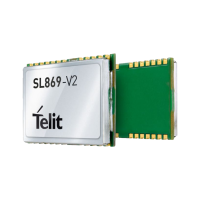10. RF FRONT END DESIGN
The SL869-V2 and SL869-V2S modules contain a preselect SAW filter in front of the RF
input. The SL869L-V2 and SL869L-V2S modules add an LNA in front of the (post-select)
SAW filter which allows the modules to work well with passive GNSS antennas. For
improved performance, or if the antenna cannot be located near the receiver, an active
antenna (that is, an antenna with a built-in low noise amplifier) can be used.
RF Signal Requirements
The receiver can achieve Cold Start acquisition with a signal level above the specified
minimum at its input. This means that it can acquire and track visible satellites, download
the necessary ephemeris data and compute the location within a 5-minute period. In the
GNSS signal acquisition process, demodulating the navigation message data is the most
difficult task, which is why Cold Start acquisition requires a higher signal level than
navigation or tracking. For the purposes of this discussion, autonomous operation is
assumed, which makes the Cold Start acquisition level the dominant design constraint.
If assistance data in the form of time or ephemeris aiding is available, acquisition can be
accomplished at lower signal levels.
The GPS signal is defined by IS-GPS-200. This document states that the signal level
received by a linearly polarized antenna having 3 dBi gain will be a minimum of -130 dBm
when the antenna is in the worst-case orientation and the satellite is 5 degrees or more
above the horizon.
In actual practice, the GPS satellites transmit slightly more power than specified, and the
signal level typically increases if a satellite has higher elevation angles.
The GLONASS signal is defined by GLONASS ICD 2008 Version 5.1. This document states
that the power level of the received RF signal from GLONASS satellite at the output of a
3dBi linearly polarized antenna is not less than -131dBm for L1 sub-band provided that
the satellite is observed at an angle of 5 degrees or more above the horizon.
Each GNSS satellite presents its own signal to the receiver, and best performance is
obtained when the signal levels are between -130 dBm and -125 dBm. These received
signal levels are determined by:
• GNSS satellite transmit power
• GNSS satellite elevation angle
• Free space path loss
• Extraneous path loss (such as rain)

